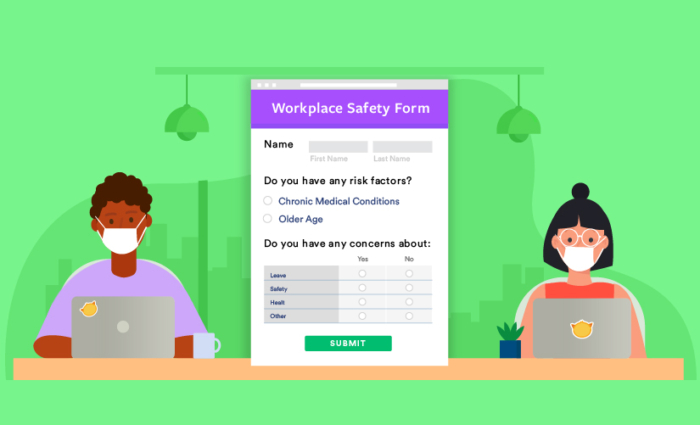Concern about safety in the workplace varies by the nature of the workplace. Before the COVID-19 pandemic, logging operations, high rise building construction, and similar businesses obviously had workplace safety concerns that an office complex or an expensive boutique did not.
Now all businesses that want to reopen have a common safety concern — protecting their employees and customers from infection. So whether your workplace is a construction site, a retail business, or an office with an open floor plan, safety protocols are more important than ever to mitigate the risk of being shut down again while more conscientious competitors continue to operate.
Infection control can be a challenge in workplaces that were designed to accommodate interaction or collaboration. But it’s not impossible.
Do your homework
Your team and customers, and every vendor you interact with, are relying on you to familiarize yourself with the advice of experts. A good place to begin is by reading this CDC fact sheet.
When a person who has COVID-19 coughs, sneezes, or even just talks, they release respiratory droplets. These droplets can be inhaled by people within six feet, or land on a surface someone else touches. Some infected people don’t show symptoms and may not realize they have the disease, which means they could spread it unknowingly.
To be safe, people must stay six feet apart, wear masks (or simple cloth face coverings), refrain from touching their faces, wash their hands frequently, and clean high-touch surfaces thoroughly and often.
Screen employees
The first step in ensuring a safe workplace during COVID-19 is prohibiting infected people from entering your place of business. Many businesses conduct daily temperature checks on employees. Some also conduct health screenings. You can ask your employees about their health and potential for exposure to COVID-19 using a health assessment form from Jotform.
Conduct a workplace hazard assessment
Begin workplace safety planning by mapping everywhere employees and/or customers are likely, if not inevitably, going to be within six feet of each other, and every surface that is routinely touched by different people in the course of the day.
The Jotform workplace safety and concerns form, which has been adapted specifically for COVID-19, invites every member of your team to share what they know and offer their suggestions.
Masks, barriers, and distance
People are social animals, so what we have to do to avoid getting or spreading COVID-19 can feel strange, but the most effective tool we have for stopping the pandemic is not breathing on each other. The three easiest ways to achieve this are with masks, barriers, and social distancing.
Masks. For any business that requires close contact, masks are a necessity. The good news is that they work! Two hairstylists who were infected with COVID-19 worked on a total of 140 clients before they were quarantined, but neither their clients nor their coworkers were infected. A recent analysis by economists at Goldman Sachs determined a national mask mandate could do as much to slow the spread of the pandemic as a drastic shutdown.
Barriers. The pandemic has sparked a boom in demand for Plexiglas as businesses scramble to separate employees, such as cashiers, from customers and from each other in situations where social distancing isn’t practical.
Distance. It’s only natural as your team gets back into the work routine for them to forget about social distancing, so you need to build it into your workplace. In offices, remove common tables from the lunch room, stagger shifts, and move desks further apart. In places like construction sites, remind workers to stay six feet apart, even during meetings and lunch, and keep meetings as short as possible.
The goal is to eliminate congregation points.
Don’t think this is temporary
When people discuss adapting safety standards in the workplace to deal with COVID-19, they often use the phrase “the new normal.” Business leaders have to assume that safety measures, despite their cost and inconvenience, will be required for a long time.
Employee safety training is a good investment for effective, ongoing workplace safety. Make it easy for every employee to monitor workplace safety with a Jotform job safety observation form.
You don’t have to wait for a COVID-19 vaccine to get back to work. Constant vigilance, by you and your team, can keep your organization in business for the duration of the pandemic.








































Send Comment: